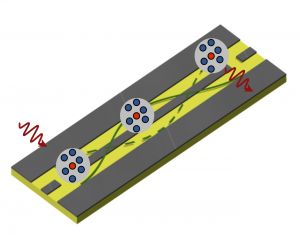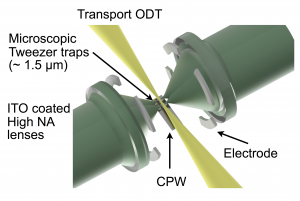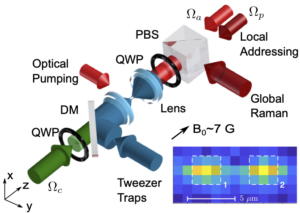Hybrid Quantum Interface: Atoms coupled to superconductors
Hybrid Quantum Systems
This project seeks to develop next-generation hardware for quantum networking by using atomic ensembles coupled to superconducting microwave circuits to generate, store and entangle photons in a single chip-based device. This offers a direct route to the creation of scalable quantum networks, in addition to future integration with ultra-fast superconducting qubits to enable distributed quantum computing.

Hybrid systems offer an alternative route to fulfilling the requirements for quantum information processing by combining disparate technologies, in this case neutral atoms and superconductors. Using established techniques of laser cooling and magnetic trapping, atoms will be manipulated above the surface of a superconducting circuit. When the atoms are excited to high-lying Rydberg states, the large dipole moments lead to strong long-range interactions which ensure only a single excitation is created, which enables single photon generation. Interestingly, these interactions lead to the creation of collective states offering an enhanced atom-photon coupling strength in addition to highly directional emission for efficient coupling between single photons and optical fibres. Finally, long range entanglement between atomic ensembles can be achieved using a cavity mediated long-range interaction. Using such a system, it should be possible to generate arbitrary entangled states between multiple optical modes as a first step towards a quantum router, a key building block for scalable quantum networking.

One application of such a hybrid system to enable active cooling of the microwave cavity mode. Our theoretical study of this system published in PRA showed efficient routes to cooling even starting from 4 K, achieving sub-Kelvin effective temperatures using a single atom with further benefits to using up to 5 atoms interacting with the same cavity mode.
Our experimental setup uses high NA lenses to create microscopic dipole traps for trapping atoms into a single blockade volume and manipulating close to the surface for a superconducting microwave coplanar waveguide resonators. Atoms are cooled in a room temperature vapour cell and transported ~ 30 cm in an optical dipole trap into the 4 K cryostat, acting as a dense reservoir for efficient loading of the micro traps.

Room temperature two-qubit gate operations
As part of the development of this platform we have demonstrated coherent control and entanglement of a pair of neutral Cs atoms using a room temperature setup, using atoms confined in microscopic optical dipole traps. These results include first demonstrations of high-fidelity imaging using an sCMOS camera, stabilising narrow-line width home-built lasers to a high-finesse cavity to obtain excellent long-term stability and demonstration of long Rydberg coherence times and ground-state entanglement using the Rydberg blockade.

More recently, using this setup we have demonstrated the UK’s first neutral atom quantum gate using a novel protocol based on electromagnetically induced transparency originally proposed by M. Müller, I. Lesanovsky and P. Zoller back in 2008, with our results published in PRL. We achieved a corrected CNOT gate fidelity of 0.82(6), mainly limited by available laser power, and used this gate to prepare a Bell state on two qubits. This provides a scalable gate protocol capable of performing a native CNOT gate and maps to CNOTN gates with N targets for stabiliser measurements in quantum error correction, for which we proposed with experimental upgrades including performing excitation via the inverted 7P1/2 transition to reach intrinsic fidelities F>0.998.

Publications
Former Members
- “Dr. Katie McDonnell - PhD Student, now at IQC Waterloo.”
- “Dr. Lindsey Keary - PhD Student, now working at Morgan Stanley.”
- “Dr. Remy Legaie - PhD Student, currently working at Rydberg Technologies.”
- “Dr Craig Picken - Now at M Squared Lasers.”
- “Felix Hoffet - UG Project: Microwave sensing with EIT using dispersive readout”
- “Ilian Despard - UG Project: Construction of Rydberg laser SHG system for microwave sensing with EIT. Currently undertaking a PhD building a Quantum Gas Microscope with Stefan Kuhr.”
- “Sukhpal Singh - UG Project calculating finite temperature effects in hybrid quantum systems”
Funding

